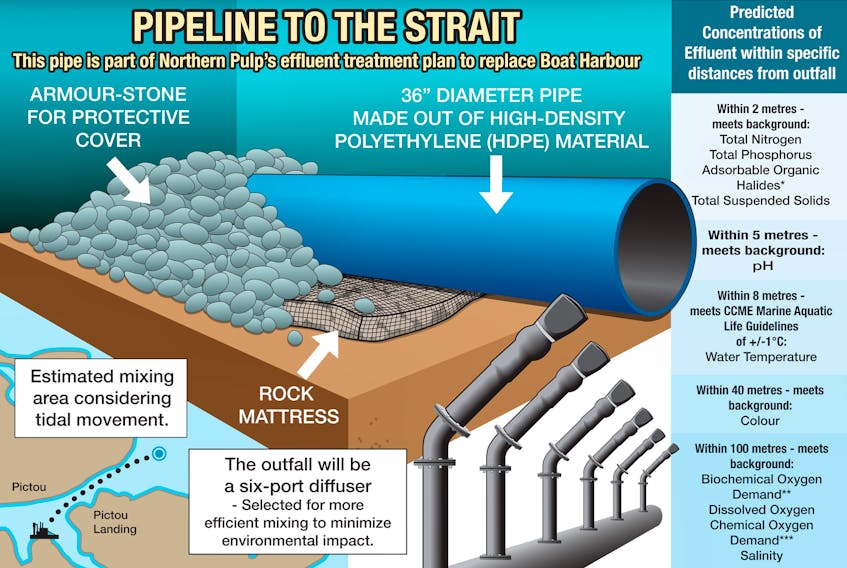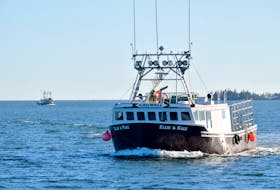There’s a test that’s common when it comes to examining the acute toxicity of effluent.
You stick trout in 100 per cent effluent and see if they survive in it for 96 hours. If the fish live and show no sign of dramatic health change, it meets the standard. If they die, it fails.
But when it comes to the complexities of how much damage pulp effluent does on a long-term basis, the answers may be less black and white according to experts that The News talked with.
In an effort to address the concerns expressed by fishermen and others about the impact that effluent released into the Northumberland Strait could have – regarding a proposed new treatment system for Northern Pulp – The News reached out to two scientists who are experts in the field of environmental monitoring as well as the engineer who was hired to design the replacement treatment facility.
Dr. Michael van den Heuvel is a professor at the University of Prince Edward Island and Canada Research chair in watershed ecological integrity. As part of his job he studies the effects of agriculture and chemical use on freshwater and coastal environments. His focus is the endocrine responses, immunotoxicology, and population health of fish. He’s also extensively studied the impact of pulp mill effluent during the last 30 years of his career.
Dr. Michelle Gray is an assistant professor at the University of New Brunswick where she teaches environment and ecosystem management. Among her areas of interest is environmental monitoring.
Both said there are two common side effects that scientists have historically seen when it comes to bleached kraft pulp effluent. The first is that it causes a degree of nutrient enrichment, which, on one hand, can cause fish and marine life to grow larger.
Gray explained that the nutrients going into the water cause more food for the bugs to eat, making them grow bigger, creating more for the fish to eat, which, in turn, can cause them to grow.
On the other hand, nutrient enrichment can lead to more environmental problems such as depleted oxygen levels near the ocean floor because it causes more algae growth, says van den Heuvel. Since lobster live along the bottom of the ocean, in theory this is where they could be impacted.
Stantec is the company hired to do a receiving waters study which looked at nitrogen and phosphorus – the two common nutrients which will be found in pulp effluent. According to their research, these nutrients will be at essentially the same level that is currently in the water within two metres of the proposed diffusing pipe.
Other areas that affect oxygen levels are chemical oxygen demand and biochemical oxygen demand. Both of these can cause low levels of oxygen in the water. Those would also be essentially the same as existing levels within 100 metres of the diffuser.
Van den Heuvel predicts the amount of nutrients released from the effluent would be small in comparison to other causes of nutrient enrichment. For example he said the Northumberland Strait is already affected by nutrients leaked into the water from Prince Edward Island where farmers often use nitrogen-based fertilizers.
While the effect of the mill shouldn’t be discounted, because it could cause an additional strain on an already overloaded system, van den Heuvel said it wouldn’t be a major contributor.
The other side effect is an impact on reproduction, with fish near waters impacted by pulp effluent often having smaller gonads, said Gray. Studies also indicate that fish exposed to pulp effluent mature later.
According to one scientific paper titled An Overview of Recent Studies on The Potential of Pulp-Mill Effluents to Alter Reproductive Parameters in Fish published in 1998, laboratory testing using fathead minnows exposed over a full life cycle showed a depression in sex steroid production, delay in sexual maturity, reduced egg production and changes in secondary sex characteristics.
To what degree those effects are seen varies widely depending on the quality and quantity of the effluent. In the past effluent was untreated and people mistakenly believed nature would take care of it. That was the case when Boat Harbour was first used as a treatment facility.
“We certainly hope that people don’t think that way anymore,” Gray said.
Now treatment has improved dramatically but Grey said “there is still some evidence of environmental impact.”
Van den Heuvel said that standards in Canada require effluent to be a certain quality before it is released and those standards have gotten increasing more stringent since 1992 when the federal government introduced the Pulp and Paper Effluent Regulations to protect fish, fish habitat, and human health. Mills are now required to conduct environmental effects monitoring (EEM) every three years to identify the impact on fish and fish habitat.
Salinity, amount of salt in the water, was also tested in the receiving water study. Projections show it would meet with the existing levels of salinity within 100 metres.
Van den Heuvel believes Northern Pulp’s proposed system would be up to modern industry standards and would be an improvement over the current system, which releases treated effluent into Boat Harbour where it subsequently flows into the Northumberland Strait.
But having a proper effluent treatment system isn’t enough.
“Treatment alone is not everything. It’s how it’s operated,” van den Heuvel said.
A system that isn’t properly run could cause more contaminated effluent to be released, which is why constant testing is needed.
Overall, van den Heuvel said that the proposed treatment system and the release of the nutrients isn’t cause for huge concern, but is something that will need to be scrutinized and will require the monitoring for environmental effects (which is already required by law).
Gray agreed it would be an improvement over what’s currently in place.
“If they’re improving the treatment, it’s probably in the long term a plus,” she said.
Guy Martin, lead project engineer with KSH Solutions, is the man responsible for the design of the new effluent treatment plant and assures it is designed according to industry best practice.
A key element that is going to be added to the Northern Pulp plant around the same time that the effluent treatment facility is replaced is a $70 million oxygen delignification system.
The system, which consists of oxygen reactors and wash presses, will be used in the process before the existing bleaching stages. The benefit is that it will result in the use of less bleaching chemicals to whiten the pulp in the existing bleach plant. It will reduce chlorine dioxide bleaching chemicals by 30-40 per cent as well as the amount of organic material by an equivalent amount. It is also expected to reduce the effluent colour and reduce wood losses.
The reduction in the organic loading would help address the problem of nutrient enrichment because it reduces the amount of organic material in the effluent.
Martin said it is the wood particles that are also believed to be responsible for the reproductive problems seen in the study on pulp effluent. Again, this will be reduced with the oxygen delignification system.
Even without that system though, Martin says the effluent will meet the environmental standards, which are tested for the worst possible conditions and the worst possible days without the oxygen delignification system in place, according to projections completed as part of their environmental assessment.
Another benefit is the fact that the pipe is located farther into the Northumberland Strait. While the location of the proposed effluent discharge has been the primary concern from fishermen, it was chosen based on projections which show it is the best place within a reasonable distance for the effluent to quickly mix with water instead of hanging around the coast in higher concentrations.
There are safety measures in place in the design as well so that in the event there was contaminated effluent in the plant it would be diverted to spill basins before it was ever released, he said.
A common misconception that people have says Northern Pulp’s technical manager Terri Fraser is that the treated effluent will be something new flowing into the Northumberland Strait. In reality it’s already been flowing there after leaving Boat Harbour and this new process will be an improvement that meets and exceeds the environmental standards.









